Financial Accounting: AASB 138 and Ramsay Health Care Limited
VerifiedAdded on 2023/01/06
|10
|2667
|41
AI Summary
This report provides an insight into the relevance and comparison of the accounting policy followed by Ramsay Health Care Limited with AASB 138 in respect to financial accounting of intangible assets.
Contribute Materials
Your contribution can guide someone’s learning journey. Share your
documents today.
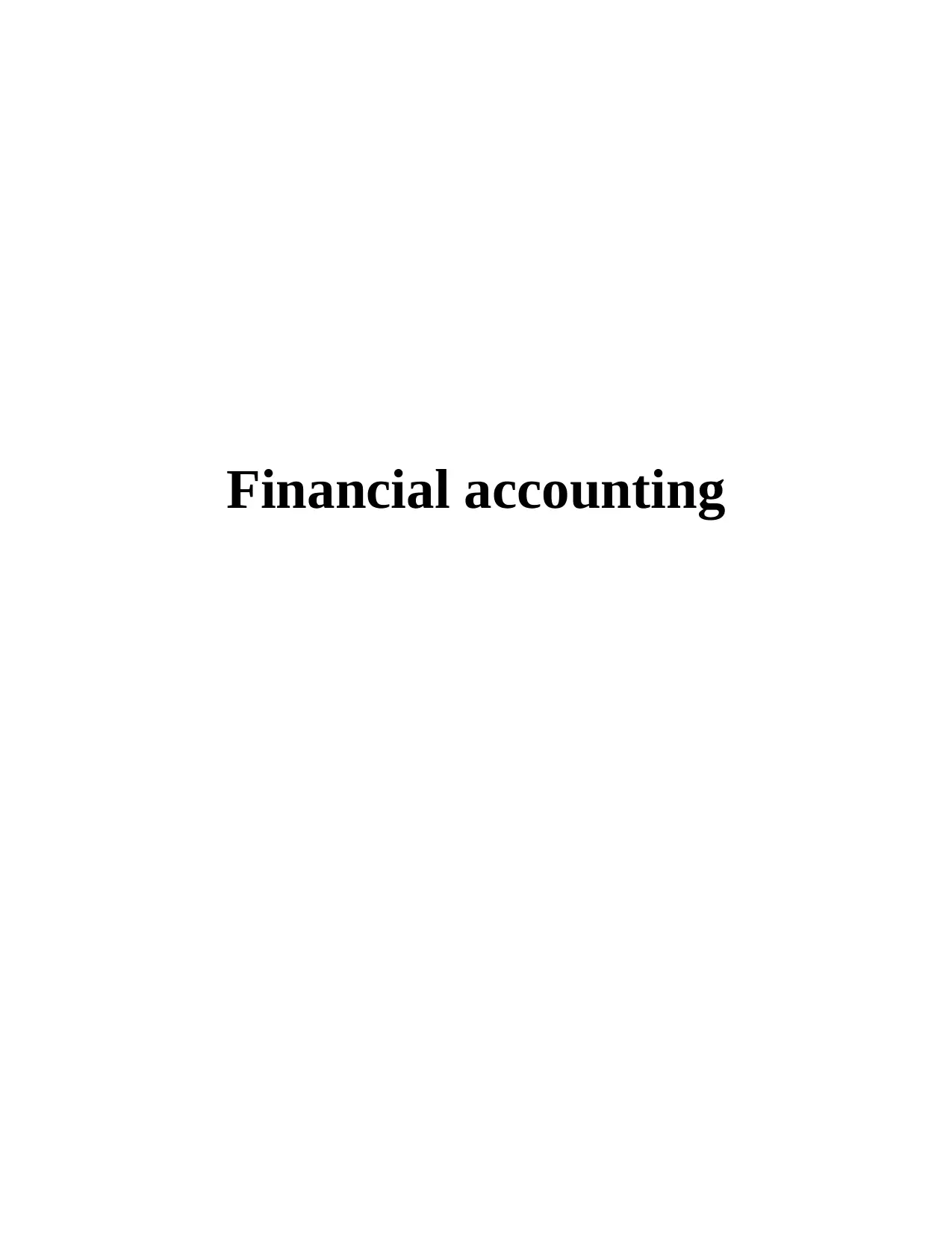
Financial accounting
Secure Best Marks with AI Grader
Need help grading? Try our AI Grader for instant feedback on your assignments.
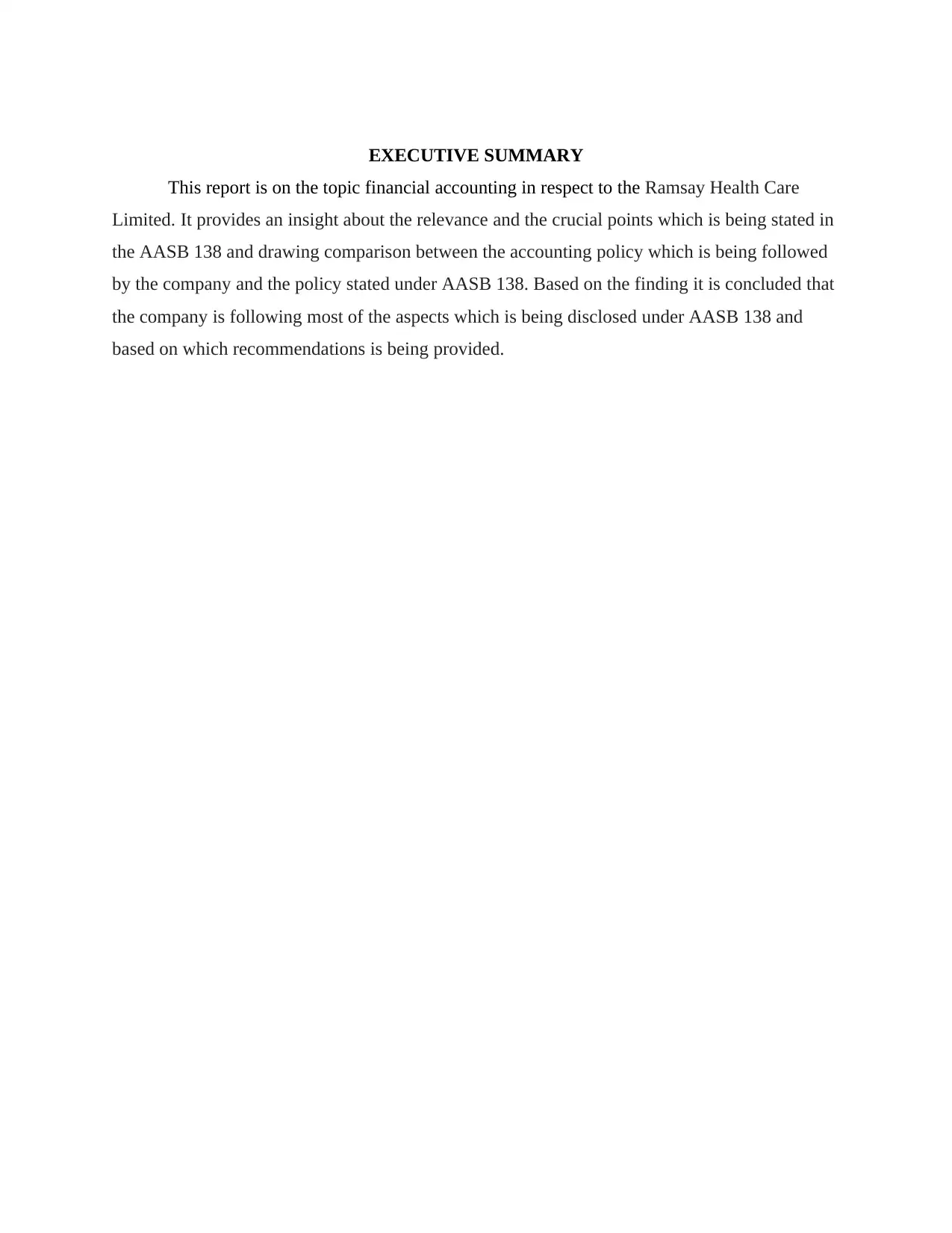
EXECUTIVE SUMMARY
This report is on the topic financial accounting in respect to the Ramsay Health Care
Limited. It provides an insight about the relevance and the crucial points which is being stated in
the AASB 138 and drawing comparison between the accounting policy which is being followed
by the company and the policy stated under AASB 138. Based on the finding it is concluded that
the company is following most of the aspects which is being disclosed under AASB 138 and
based on which recommendations is being provided.
This report is on the topic financial accounting in respect to the Ramsay Health Care
Limited. It provides an insight about the relevance and the crucial points which is being stated in
the AASB 138 and drawing comparison between the accounting policy which is being followed
by the company and the policy stated under AASB 138. Based on the finding it is concluded that
the company is following most of the aspects which is being disclosed under AASB 138 and
based on which recommendations is being provided.
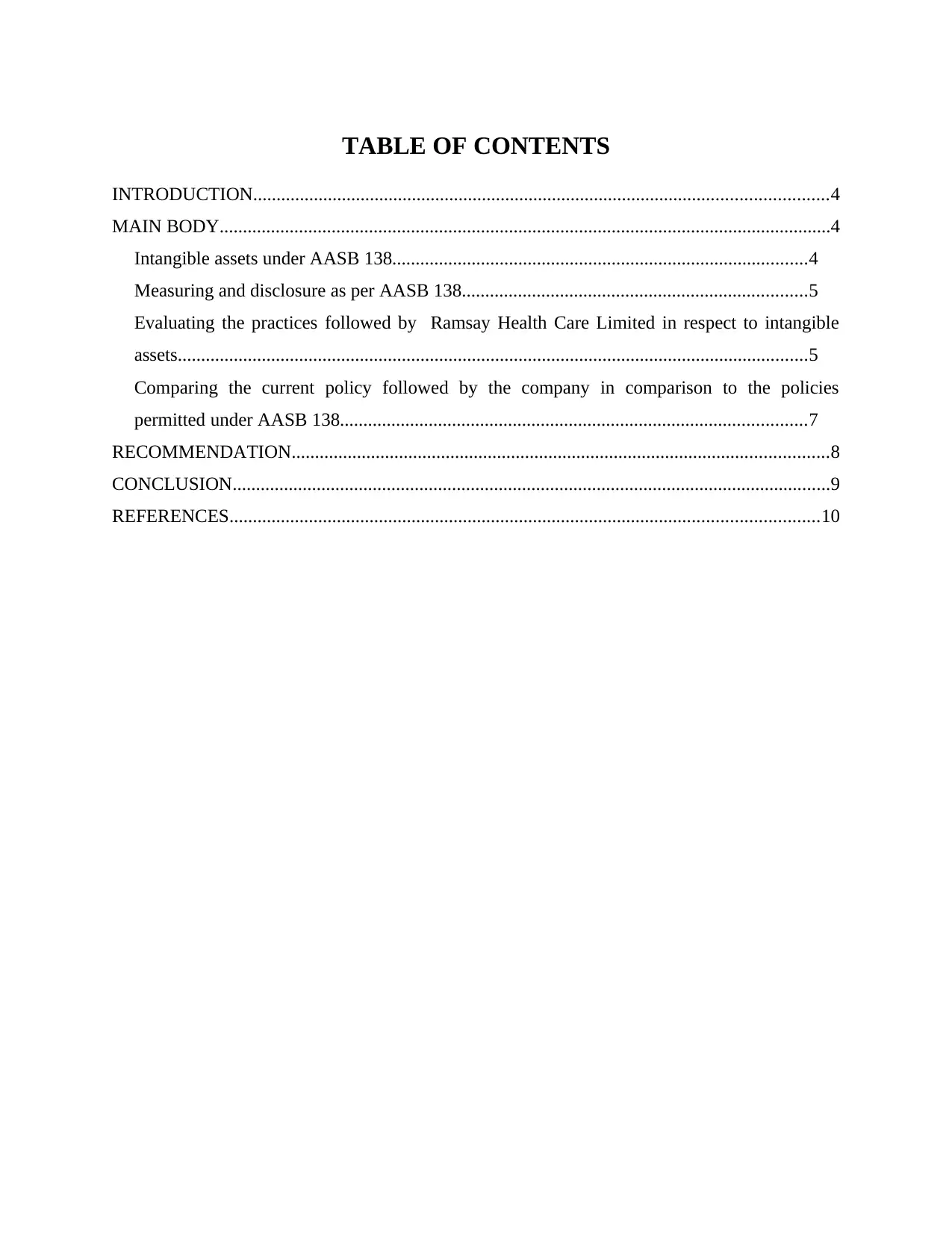
TABLE OF CONTENTS
INTRODUCTION...........................................................................................................................4
MAIN BODY...................................................................................................................................4
Intangible assets under AASB 138.........................................................................................4
Measuring and disclosure as per AASB 138..........................................................................5
Evaluating the practices followed by Ramsay Health Care Limited in respect to intangible
assets.......................................................................................................................................5
Comparing the current policy followed by the company in comparison to the policies
permitted under AASB 138....................................................................................................7
RECOMMENDATION...................................................................................................................8
CONCLUSION................................................................................................................................9
REFERENCES..............................................................................................................................10
INTRODUCTION...........................................................................................................................4
MAIN BODY...................................................................................................................................4
Intangible assets under AASB 138.........................................................................................4
Measuring and disclosure as per AASB 138..........................................................................5
Evaluating the practices followed by Ramsay Health Care Limited in respect to intangible
assets.......................................................................................................................................5
Comparing the current policy followed by the company in comparison to the policies
permitted under AASB 138....................................................................................................7
RECOMMENDATION...................................................................................................................8
CONCLUSION................................................................................................................................9
REFERENCES..............................................................................................................................10
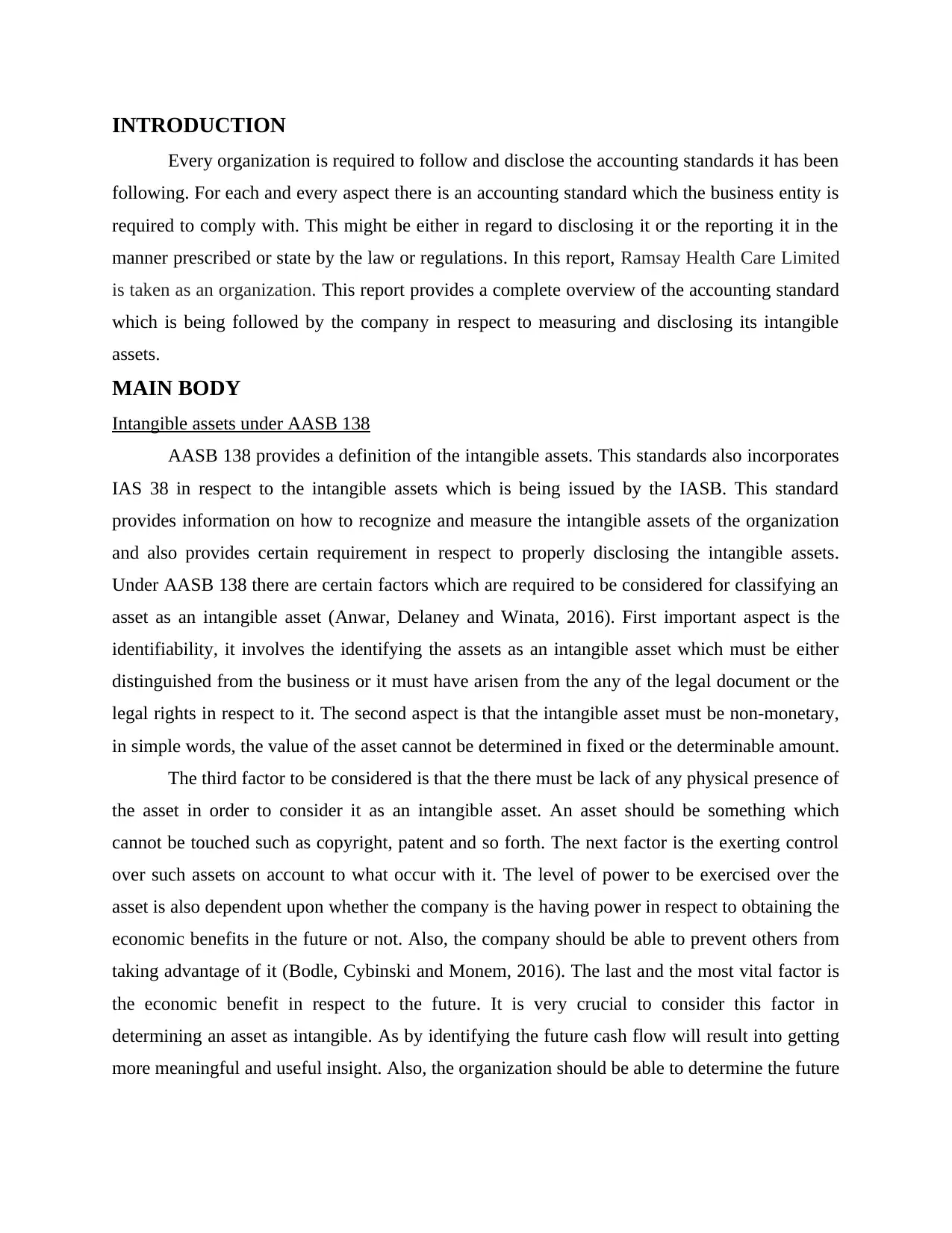
INTRODUCTION
Every organization is required to follow and disclose the accounting standards it has been
following. For each and every aspect there is an accounting standard which the business entity is
required to comply with. This might be either in regard to disclosing it or the reporting it in the
manner prescribed or state by the law or regulations. In this report, Ramsay Health Care Limited
is taken as an organization. This report provides a complete overview of the accounting standard
which is being followed by the company in respect to measuring and disclosing its intangible
assets.
MAIN BODY
Intangible assets under AASB 138
AASB 138 provides a definition of the intangible assets. This standards also incorporates
IAS 38 in respect to the intangible assets which is being issued by the IASB. This standard
provides information on how to recognize and measure the intangible assets of the organization
and also provides certain requirement in respect to properly disclosing the intangible assets.
Under AASB 138 there are certain factors which are required to be considered for classifying an
asset as an intangible asset (Anwar, Delaney and Winata, 2016). First important aspect is the
identifiability, it involves the identifying the assets as an intangible asset which must be either
distinguished from the business or it must have arisen from the any of the legal document or the
legal rights in respect to it. The second aspect is that the intangible asset must be non-monetary,
in simple words, the value of the asset cannot be determined in fixed or the determinable amount.
The third factor to be considered is that the there must be lack of any physical presence of
the asset in order to consider it as an intangible asset. An asset should be something which
cannot be touched such as copyright, patent and so forth. The next factor is the exerting control
over such assets on account to what occur with it. The level of power to be exercised over the
asset is also dependent upon whether the company is the having power in respect to obtaining the
economic benefits in the future or not. Also, the company should be able to prevent others from
taking advantage of it (Bodle, Cybinski and Monem, 2016). The last and the most vital factor is
the economic benefit in respect to the future. It is very crucial to consider this factor in
determining an asset as intangible. As by identifying the future cash flow will result into getting
more meaningful and useful insight. Also, the organization should be able to determine the future
Every organization is required to follow and disclose the accounting standards it has been
following. For each and every aspect there is an accounting standard which the business entity is
required to comply with. This might be either in regard to disclosing it or the reporting it in the
manner prescribed or state by the law or regulations. In this report, Ramsay Health Care Limited
is taken as an organization. This report provides a complete overview of the accounting standard
which is being followed by the company in respect to measuring and disclosing its intangible
assets.
MAIN BODY
Intangible assets under AASB 138
AASB 138 provides a definition of the intangible assets. This standards also incorporates
IAS 38 in respect to the intangible assets which is being issued by the IASB. This standard
provides information on how to recognize and measure the intangible assets of the organization
and also provides certain requirement in respect to properly disclosing the intangible assets.
Under AASB 138 there are certain factors which are required to be considered for classifying an
asset as an intangible asset (Anwar, Delaney and Winata, 2016). First important aspect is the
identifiability, it involves the identifying the assets as an intangible asset which must be either
distinguished from the business or it must have arisen from the any of the legal document or the
legal rights in respect to it. The second aspect is that the intangible asset must be non-monetary,
in simple words, the value of the asset cannot be determined in fixed or the determinable amount.
The third factor to be considered is that the there must be lack of any physical presence of
the asset in order to consider it as an intangible asset. An asset should be something which
cannot be touched such as copyright, patent and so forth. The next factor is the exerting control
over such assets on account to what occur with it. The level of power to be exercised over the
asset is also dependent upon whether the company is the having power in respect to obtaining the
economic benefits in the future or not. Also, the company should be able to prevent others from
taking advantage of it (Bodle, Cybinski and Monem, 2016). The last and the most vital factor is
the economic benefit in respect to the future. It is very crucial to consider this factor in
determining an asset as intangible. As by identifying the future cash flow will result into getting
more meaningful and useful insight. Also, the organization should be able to determine the future
Secure Best Marks with AI Grader
Need help grading? Try our AI Grader for instant feedback on your assignments.
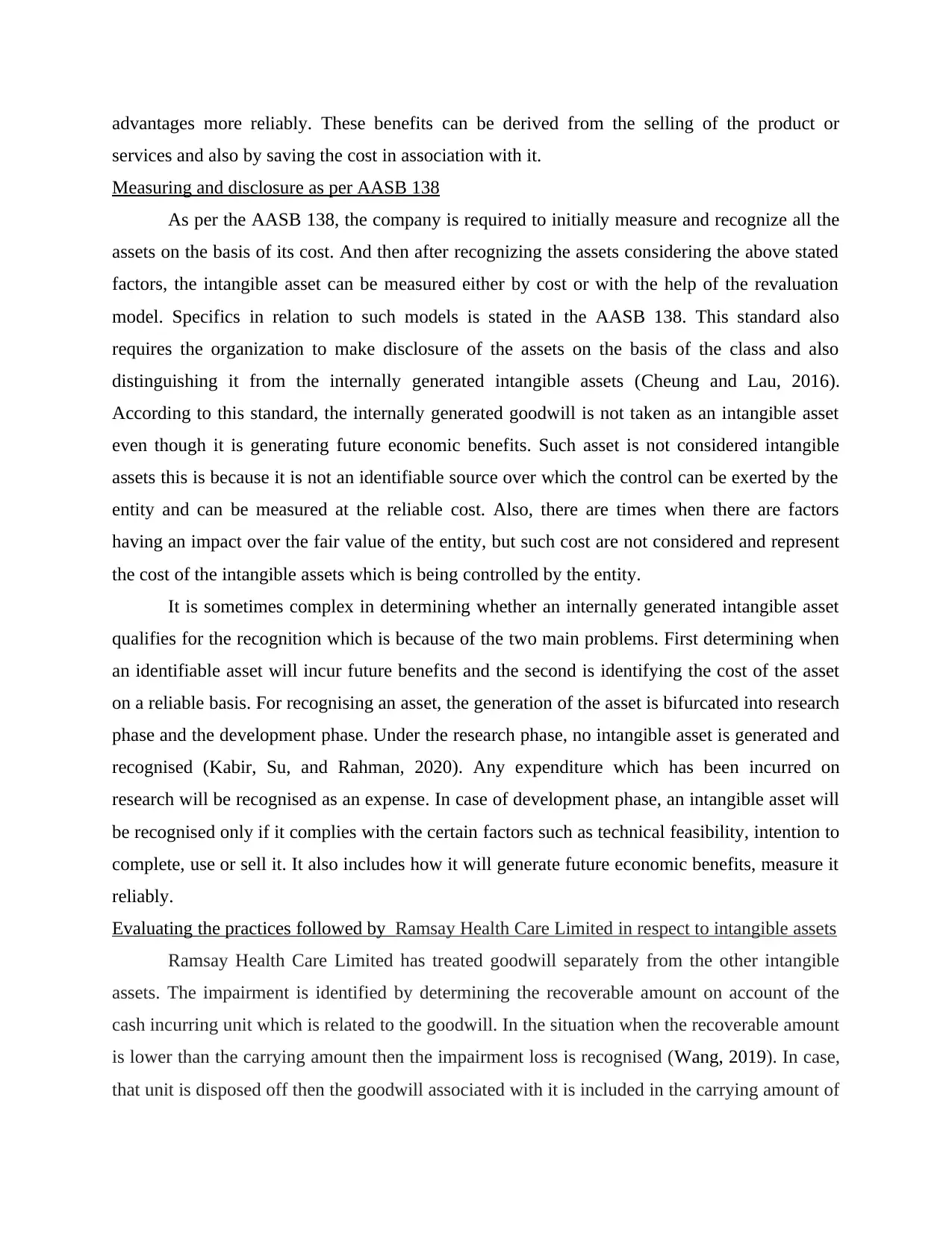
advantages more reliably. These benefits can be derived from the selling of the product or
services and also by saving the cost in association with it.
Measuring and disclosure as per AASB 138
As per the AASB 138, the company is required to initially measure and recognize all the
assets on the basis of its cost. And then after recognizing the assets considering the above stated
factors, the intangible asset can be measured either by cost or with the help of the revaluation
model. Specifics in relation to such models is stated in the AASB 138. This standard also
requires the organization to make disclosure of the assets on the basis of the class and also
distinguishing it from the internally generated intangible assets (Cheung and Lau, 2016).
According to this standard, the internally generated goodwill is not taken as an intangible asset
even though it is generating future economic benefits. Such asset is not considered intangible
assets this is because it is not an identifiable source over which the control can be exerted by the
entity and can be measured at the reliable cost. Also, there are times when there are factors
having an impact over the fair value of the entity, but such cost are not considered and represent
the cost of the intangible assets which is being controlled by the entity.
It is sometimes complex in determining whether an internally generated intangible asset
qualifies for the recognition which is because of the two main problems. First determining when
an identifiable asset will incur future benefits and the second is identifying the cost of the asset
on a reliable basis. For recognising an asset, the generation of the asset is bifurcated into research
phase and the development phase. Under the research phase, no intangible asset is generated and
recognised (Kabir, Su, and Rahman, 2020). Any expenditure which has been incurred on
research will be recognised as an expense. In case of development phase, an intangible asset will
be recognised only if it complies with the certain factors such as technical feasibility, intention to
complete, use or sell it. It also includes how it will generate future economic benefits, measure it
reliably.
Evaluating the practices followed by Ramsay Health Care Limited in respect to intangible assets
Ramsay Health Care Limited has treated goodwill separately from the other intangible
assets. The impairment is identified by determining the recoverable amount on account of the
cash incurring unit which is related to the goodwill. In the situation when the recoverable amount
is lower than the carrying amount then the impairment loss is recognised (Wang, 2019). In case,
that unit is disposed off then the goodwill associated with it is included in the carrying amount of
services and also by saving the cost in association with it.
Measuring and disclosure as per AASB 138
As per the AASB 138, the company is required to initially measure and recognize all the
assets on the basis of its cost. And then after recognizing the assets considering the above stated
factors, the intangible asset can be measured either by cost or with the help of the revaluation
model. Specifics in relation to such models is stated in the AASB 138. This standard also
requires the organization to make disclosure of the assets on the basis of the class and also
distinguishing it from the internally generated intangible assets (Cheung and Lau, 2016).
According to this standard, the internally generated goodwill is not taken as an intangible asset
even though it is generating future economic benefits. Such asset is not considered intangible
assets this is because it is not an identifiable source over which the control can be exerted by the
entity and can be measured at the reliable cost. Also, there are times when there are factors
having an impact over the fair value of the entity, but such cost are not considered and represent
the cost of the intangible assets which is being controlled by the entity.
It is sometimes complex in determining whether an internally generated intangible asset
qualifies for the recognition which is because of the two main problems. First determining when
an identifiable asset will incur future benefits and the second is identifying the cost of the asset
on a reliable basis. For recognising an asset, the generation of the asset is bifurcated into research
phase and the development phase. Under the research phase, no intangible asset is generated and
recognised (Kabir, Su, and Rahman, 2020). Any expenditure which has been incurred on
research will be recognised as an expense. In case of development phase, an intangible asset will
be recognised only if it complies with the certain factors such as technical feasibility, intention to
complete, use or sell it. It also includes how it will generate future economic benefits, measure it
reliably.
Evaluating the practices followed by Ramsay Health Care Limited in respect to intangible assets
Ramsay Health Care Limited has treated goodwill separately from the other intangible
assets. The impairment is identified by determining the recoverable amount on account of the
cash incurring unit which is related to the goodwill. In the situation when the recoverable amount
is lower than the carrying amount then the impairment loss is recognised (Wang, 2019). In case,
that unit is disposed off then the goodwill associated with it is included in the carrying amount of
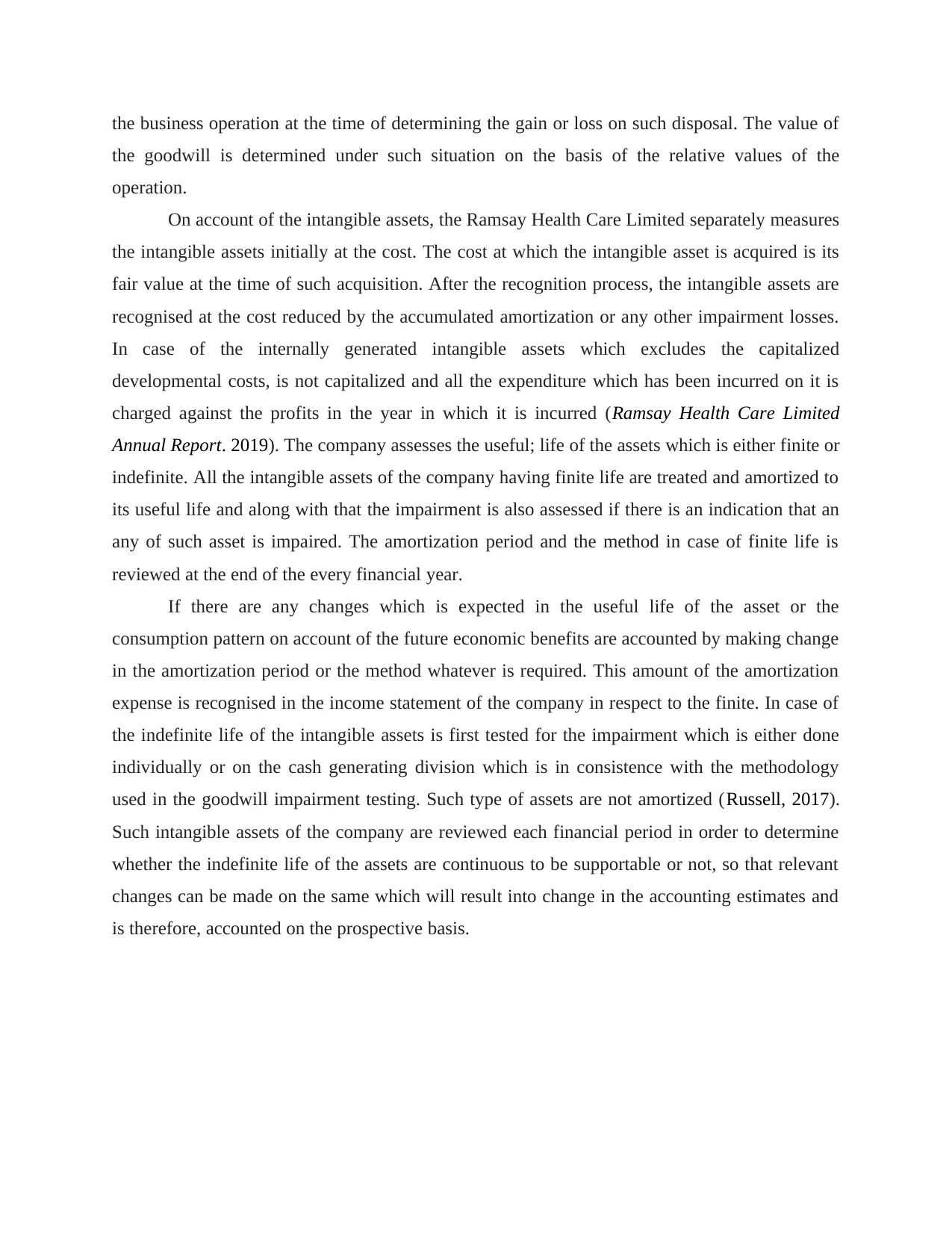
the business operation at the time of determining the gain or loss on such disposal. The value of
the goodwill is determined under such situation on the basis of the relative values of the
operation.
On account of the intangible assets, the Ramsay Health Care Limited separately measures
the intangible assets initially at the cost. The cost at which the intangible asset is acquired is its
fair value at the time of such acquisition. After the recognition process, the intangible assets are
recognised at the cost reduced by the accumulated amortization or any other impairment losses.
In case of the internally generated intangible assets which excludes the capitalized
developmental costs, is not capitalized and all the expenditure which has been incurred on it is
charged against the profits in the year in which it is incurred (Ramsay Health Care Limited
Annual Report. 2019). The company assesses the useful; life of the assets which is either finite or
indefinite. All the intangible assets of the company having finite life are treated and amortized to
its useful life and along with that the impairment is also assessed if there is an indication that an
any of such asset is impaired. The amortization period and the method in case of finite life is
reviewed at the end of the every financial year.
If there are any changes which is expected in the useful life of the asset or the
consumption pattern on account of the future economic benefits are accounted by making change
in the amortization period or the method whatever is required. This amount of the amortization
expense is recognised in the income statement of the company in respect to the finite. In case of
the indefinite life of the intangible assets is first tested for the impairment which is either done
individually or on the cash generating division which is in consistence with the methodology
used in the goodwill impairment testing. Such type of assets are not amortized (Russell, 2017).
Such intangible assets of the company are reviewed each financial period in order to determine
whether the indefinite life of the assets are continuous to be supportable or not, so that relevant
changes can be made on the same which will result into change in the accounting estimates and
is therefore, accounted on the prospective basis.
the goodwill is determined under such situation on the basis of the relative values of the
operation.
On account of the intangible assets, the Ramsay Health Care Limited separately measures
the intangible assets initially at the cost. The cost at which the intangible asset is acquired is its
fair value at the time of such acquisition. After the recognition process, the intangible assets are
recognised at the cost reduced by the accumulated amortization or any other impairment losses.
In case of the internally generated intangible assets which excludes the capitalized
developmental costs, is not capitalized and all the expenditure which has been incurred on it is
charged against the profits in the year in which it is incurred (Ramsay Health Care Limited
Annual Report. 2019). The company assesses the useful; life of the assets which is either finite or
indefinite. All the intangible assets of the company having finite life are treated and amortized to
its useful life and along with that the impairment is also assessed if there is an indication that an
any of such asset is impaired. The amortization period and the method in case of finite life is
reviewed at the end of the every financial year.
If there are any changes which is expected in the useful life of the asset or the
consumption pattern on account of the future economic benefits are accounted by making change
in the amortization period or the method whatever is required. This amount of the amortization
expense is recognised in the income statement of the company in respect to the finite. In case of
the indefinite life of the intangible assets is first tested for the impairment which is either done
individually or on the cash generating division which is in consistence with the methodology
used in the goodwill impairment testing. Such type of assets are not amortized (Russell, 2017).
Such intangible assets of the company are reviewed each financial period in order to determine
whether the indefinite life of the assets are continuous to be supportable or not, so that relevant
changes can be made on the same which will result into change in the accounting estimates and
is therefore, accounted on the prospective basis.
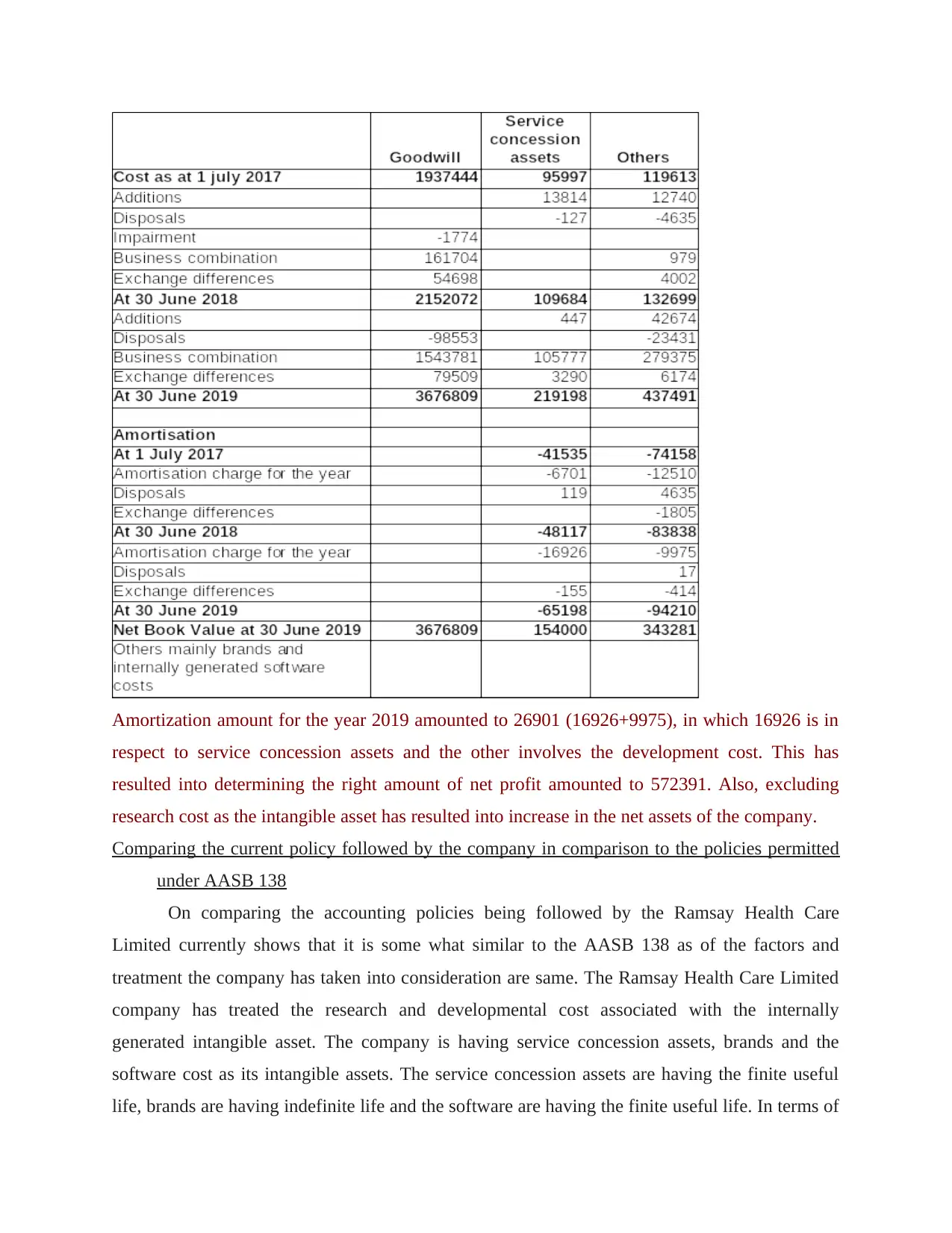
Amortization amount for the year 2019 amounted to 26901 (16926+9975), in which 16926 is in
respect to service concession assets and the other involves the development cost. This has
resulted into determining the right amount of net profit amounted to 572391. Also, excluding
research cost as the intangible asset has resulted into increase in the net assets of the company.
Comparing the current policy followed by the company in comparison to the policies permitted
under AASB 138
On comparing the accounting policies being followed by the Ramsay Health Care
Limited currently shows that it is some what similar to the AASB 138 as of the factors and
treatment the company has taken into consideration are same. The Ramsay Health Care Limited
company has treated the research and developmental cost associated with the internally
generated intangible asset. The company is having service concession assets, brands and the
software cost as its intangible assets. The service concession assets are having the finite useful
life, brands are having indefinite life and the software are having the finite useful life. In terms of
respect to service concession assets and the other involves the development cost. This has
resulted into determining the right amount of net profit amounted to 572391. Also, excluding
research cost as the intangible asset has resulted into increase in the net assets of the company.
Comparing the current policy followed by the company in comparison to the policies permitted
under AASB 138
On comparing the accounting policies being followed by the Ramsay Health Care
Limited currently shows that it is some what similar to the AASB 138 as of the factors and
treatment the company has taken into consideration are same. The Ramsay Health Care Limited
company has treated the research and developmental cost associated with the internally
generated intangible asset. The company is having service concession assets, brands and the
software cost as its intangible assets. The service concession assets are having the finite useful
life, brands are having indefinite life and the software are having the finite useful life. In terms of
Paraphrase This Document
Need a fresh take? Get an instant paraphrase of this document with our AI Paraphraser
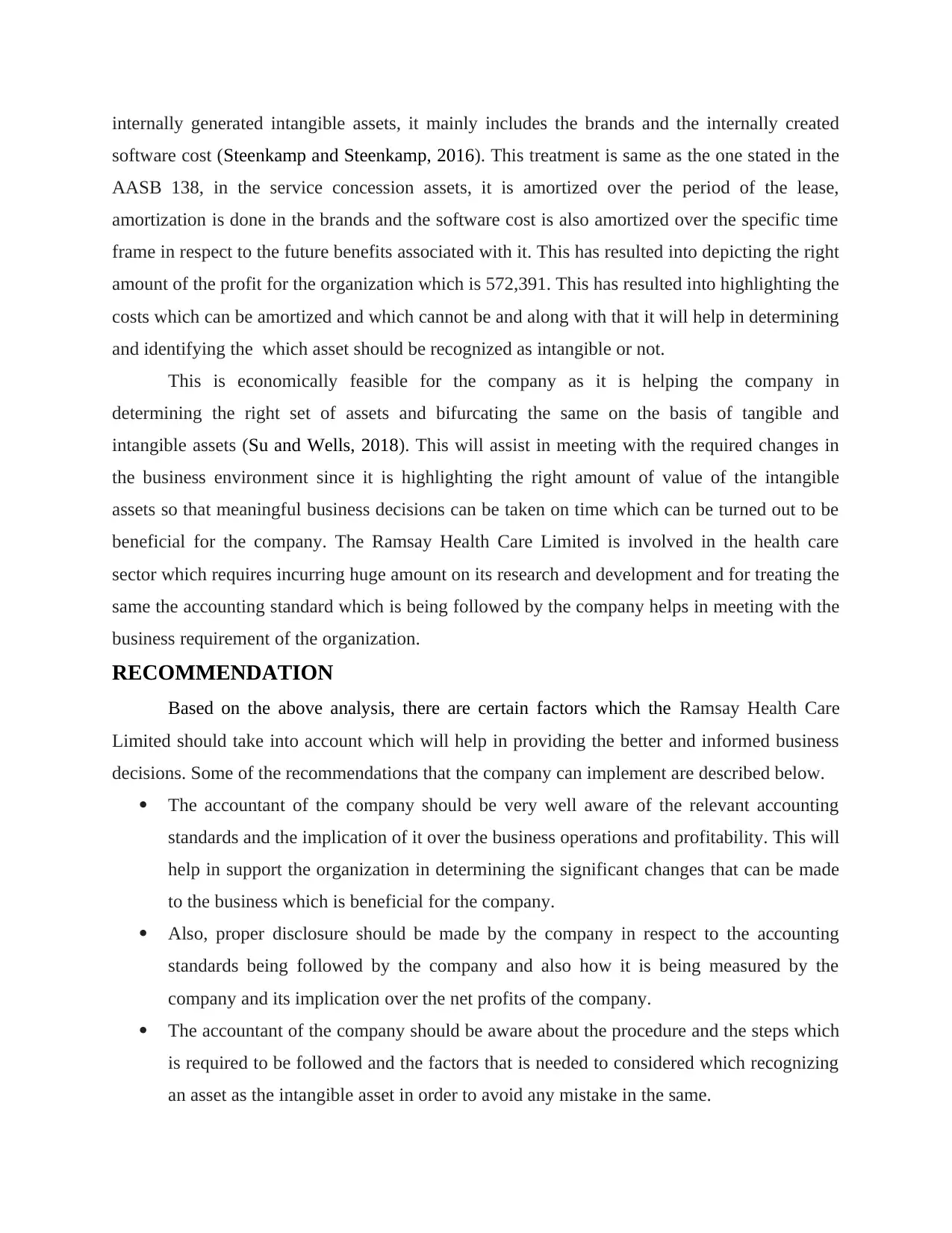
internally generated intangible assets, it mainly includes the brands and the internally created
software cost (Steenkamp and Steenkamp, 2016). This treatment is same as the one stated in the
AASB 138, in the service concession assets, it is amortized over the period of the lease,
amortization is done in the brands and the software cost is also amortized over the specific time
frame in respect to the future benefits associated with it. This has resulted into depicting the right
amount of the profit for the organization which is 572,391. This has resulted into highlighting the
costs which can be amortized and which cannot be and along with that it will help in determining
and identifying the which asset should be recognized as intangible or not.
This is economically feasible for the company as it is helping the company in
determining the right set of assets and bifurcating the same on the basis of tangible and
intangible assets (Su and Wells, 2018). This will assist in meeting with the required changes in
the business environment since it is highlighting the right amount of value of the intangible
assets so that meaningful business decisions can be taken on time which can be turned out to be
beneficial for the company. The Ramsay Health Care Limited is involved in the health care
sector which requires incurring huge amount on its research and development and for treating the
same the accounting standard which is being followed by the company helps in meeting with the
business requirement of the organization.
RECOMMENDATION
Based on the above analysis, there are certain factors which the Ramsay Health Care
Limited should take into account which will help in providing the better and informed business
decisions. Some of the recommendations that the company can implement are described below.
The accountant of the company should be very well aware of the relevant accounting
standards and the implication of it over the business operations and profitability. This will
help in support the organization in determining the significant changes that can be made
to the business which is beneficial for the company.
Also, proper disclosure should be made by the company in respect to the accounting
standards being followed by the company and also how it is being measured by the
company and its implication over the net profits of the company.
The accountant of the company should be aware about the procedure and the steps which
is required to be followed and the factors that is needed to considered which recognizing
an asset as the intangible asset in order to avoid any mistake in the same.
software cost (Steenkamp and Steenkamp, 2016). This treatment is same as the one stated in the
AASB 138, in the service concession assets, it is amortized over the period of the lease,
amortization is done in the brands and the software cost is also amortized over the specific time
frame in respect to the future benefits associated with it. This has resulted into depicting the right
amount of the profit for the organization which is 572,391. This has resulted into highlighting the
costs which can be amortized and which cannot be and along with that it will help in determining
and identifying the which asset should be recognized as intangible or not.
This is economically feasible for the company as it is helping the company in
determining the right set of assets and bifurcating the same on the basis of tangible and
intangible assets (Su and Wells, 2018). This will assist in meeting with the required changes in
the business environment since it is highlighting the right amount of value of the intangible
assets so that meaningful business decisions can be taken on time which can be turned out to be
beneficial for the company. The Ramsay Health Care Limited is involved in the health care
sector which requires incurring huge amount on its research and development and for treating the
same the accounting standard which is being followed by the company helps in meeting with the
business requirement of the organization.
RECOMMENDATION
Based on the above analysis, there are certain factors which the Ramsay Health Care
Limited should take into account which will help in providing the better and informed business
decisions. Some of the recommendations that the company can implement are described below.
The accountant of the company should be very well aware of the relevant accounting
standards and the implication of it over the business operations and profitability. This will
help in support the organization in determining the significant changes that can be made
to the business which is beneficial for the company.
Also, proper disclosure should be made by the company in respect to the accounting
standards being followed by the company and also how it is being measured by the
company and its implication over the net profits of the company.
The accountant of the company should be aware about the procedure and the steps which
is required to be followed and the factors that is needed to considered which recognizing
an asset as the intangible asset in order to avoid any mistake in the same.
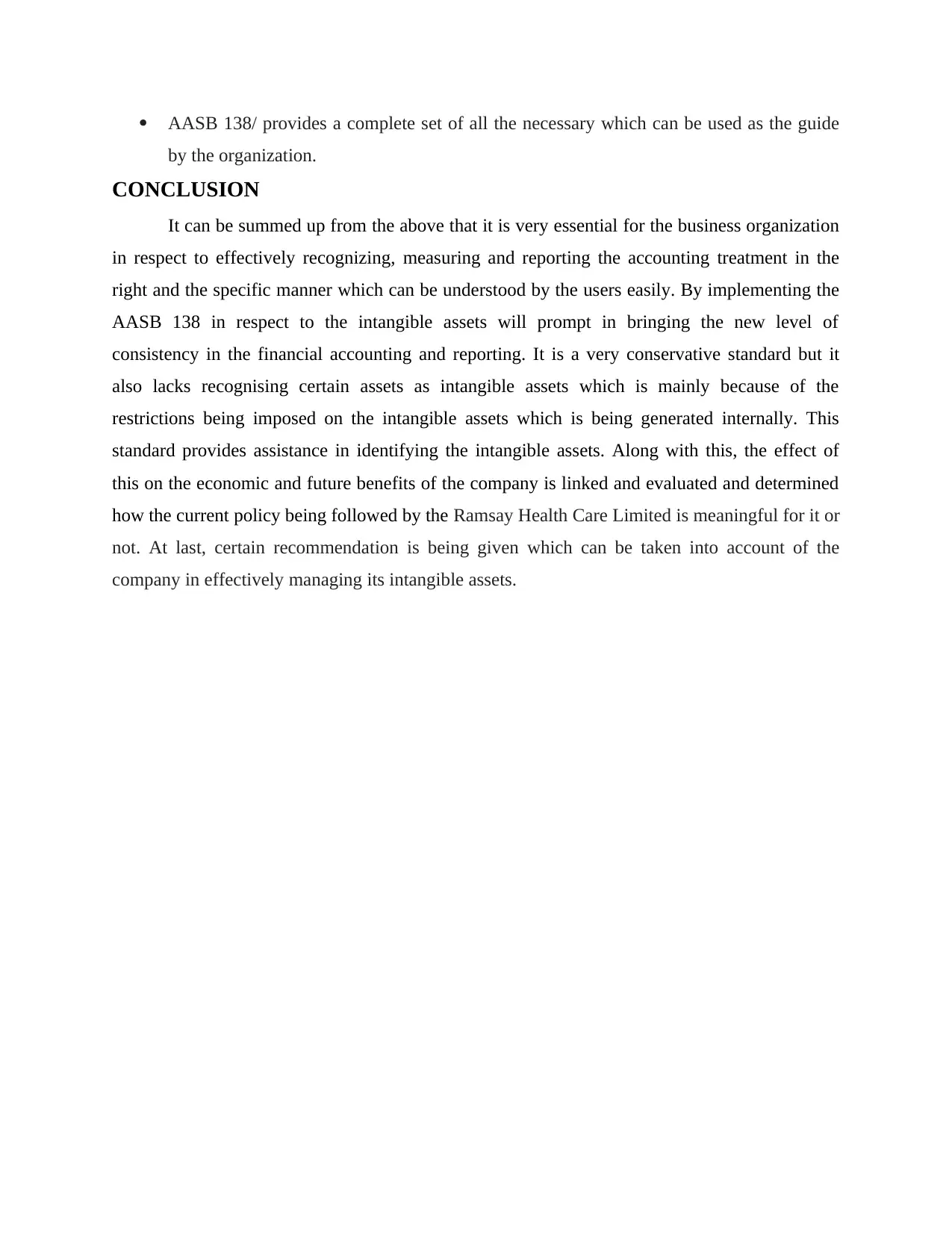
AASB 138/ provides a complete set of all the necessary which can be used as the guide
by the organization.
CONCLUSION
It can be summed up from the above that it is very essential for the business organization
in respect to effectively recognizing, measuring and reporting the accounting treatment in the
right and the specific manner which can be understood by the users easily. By implementing the
AASB 138 in respect to the intangible assets will prompt in bringing the new level of
consistency in the financial accounting and reporting. It is a very conservative standard but it
also lacks recognising certain assets as intangible assets which is mainly because of the
restrictions being imposed on the intangible assets which is being generated internally. This
standard provides assistance in identifying the intangible assets. Along with this, the effect of
this on the economic and future benefits of the company is linked and evaluated and determined
how the current policy being followed by the Ramsay Health Care Limited is meaningful for it or
not. At last, certain recommendation is being given which can be taken into account of the
company in effectively managing its intangible assets.
by the organization.
CONCLUSION
It can be summed up from the above that it is very essential for the business organization
in respect to effectively recognizing, measuring and reporting the accounting treatment in the
right and the specific manner which can be understood by the users easily. By implementing the
AASB 138 in respect to the intangible assets will prompt in bringing the new level of
consistency in the financial accounting and reporting. It is a very conservative standard but it
also lacks recognising certain assets as intangible assets which is mainly because of the
restrictions being imposed on the intangible assets which is being generated internally. This
standard provides assistance in identifying the intangible assets. Along with this, the effect of
this on the economic and future benefits of the company is linked and evaluated and determined
how the current policy being followed by the Ramsay Health Care Limited is meaningful for it or
not. At last, certain recommendation is being given which can be taken into account of the
company in effectively managing its intangible assets.
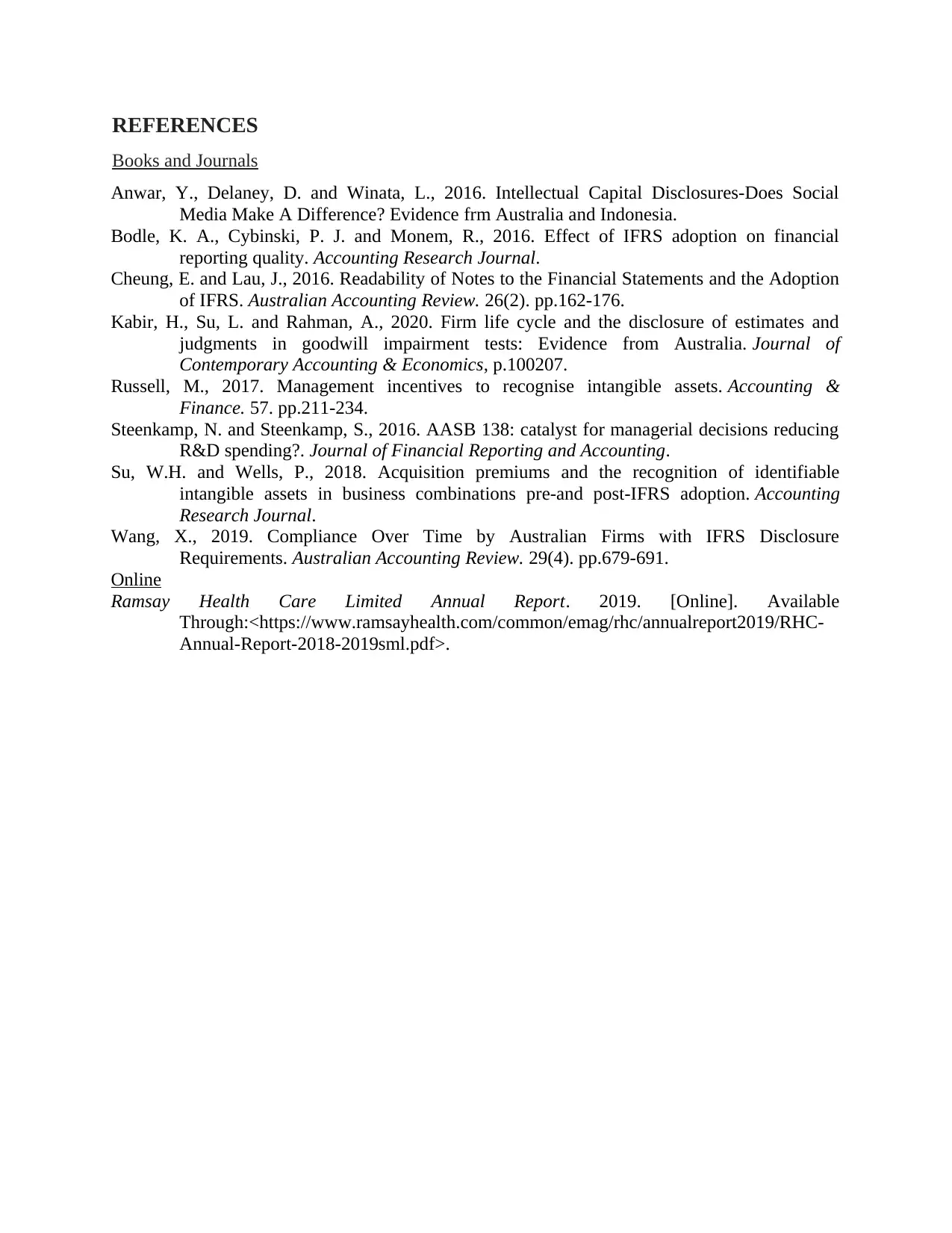
REFERENCES
Books and Journals
Anwar, Y., Delaney, D. and Winata, L., 2016. Intellectual Capital Disclosures-Does Social
Media Make A Difference? Evidence frm Australia and Indonesia.
Bodle, K. A., Cybinski, P. J. and Monem, R., 2016. Effect of IFRS adoption on financial
reporting quality. Accounting Research Journal.
Cheung, E. and Lau, J., 2016. Readability of Notes to the Financial Statements and the Adoption
of IFRS. Australian Accounting Review. 26(2). pp.162-176.
Kabir, H., Su, L. and Rahman, A., 2020. Firm life cycle and the disclosure of estimates and
judgments in goodwill impairment tests: Evidence from Australia. Journal of
Contemporary Accounting & Economics, p.100207.
Russell, M., 2017. Management incentives to recognise intangible assets. Accounting &
Finance. 57. pp.211-234.
Steenkamp, N. and Steenkamp, S., 2016. AASB 138: catalyst for managerial decisions reducing
R&D spending?. Journal of Financial Reporting and Accounting.
Su, W.H. and Wells, P., 2018. Acquisition premiums and the recognition of identifiable
intangible assets in business combinations pre-and post-IFRS adoption. Accounting
Research Journal.
Wang, X., 2019. Compliance Over Time by Australian Firms with IFRS Disclosure
Requirements. Australian Accounting Review. 29(4). pp.679-691.
Online
Ramsay Health Care Limited Annual Report. 2019. [Online]. Available
Through:<https://www.ramsayhealth.com/common/emag/rhc/annualreport2019/RHC-
Annual-Report-2018-2019sml.pdf>.
Books and Journals
Anwar, Y., Delaney, D. and Winata, L., 2016. Intellectual Capital Disclosures-Does Social
Media Make A Difference? Evidence frm Australia and Indonesia.
Bodle, K. A., Cybinski, P. J. and Monem, R., 2016. Effect of IFRS adoption on financial
reporting quality. Accounting Research Journal.
Cheung, E. and Lau, J., 2016. Readability of Notes to the Financial Statements and the Adoption
of IFRS. Australian Accounting Review. 26(2). pp.162-176.
Kabir, H., Su, L. and Rahman, A., 2020. Firm life cycle and the disclosure of estimates and
judgments in goodwill impairment tests: Evidence from Australia. Journal of
Contemporary Accounting & Economics, p.100207.
Russell, M., 2017. Management incentives to recognise intangible assets. Accounting &
Finance. 57. pp.211-234.
Steenkamp, N. and Steenkamp, S., 2016. AASB 138: catalyst for managerial decisions reducing
R&D spending?. Journal of Financial Reporting and Accounting.
Su, W.H. and Wells, P., 2018. Acquisition premiums and the recognition of identifiable
intangible assets in business combinations pre-and post-IFRS adoption. Accounting
Research Journal.
Wang, X., 2019. Compliance Over Time by Australian Firms with IFRS Disclosure
Requirements. Australian Accounting Review. 29(4). pp.679-691.
Online
Ramsay Health Care Limited Annual Report. 2019. [Online]. Available
Through:<https://www.ramsayhealth.com/common/emag/rhc/annualreport2019/RHC-
Annual-Report-2018-2019sml.pdf>.
1 out of 10
Related Documents
Your All-in-One AI-Powered Toolkit for Academic Success.
+13062052269
info@desklib.com
Available 24*7 on WhatsApp / Email
![[object Object]](/_next/static/media/star-bottom.7253800d.svg)
Unlock your academic potential
© 2024 | Zucol Services PVT LTD | All rights reserved.





